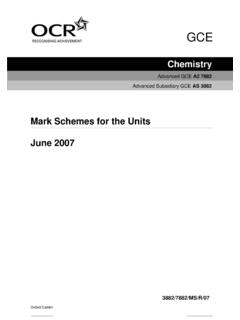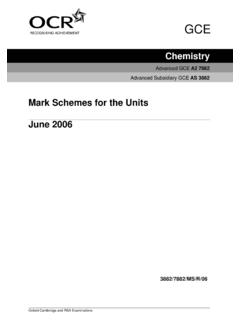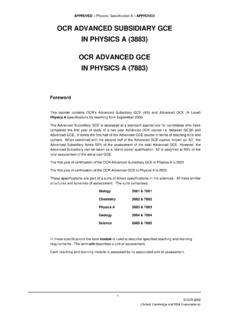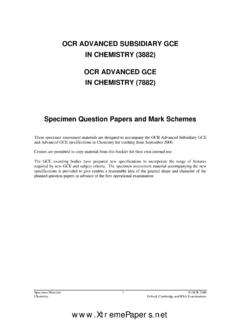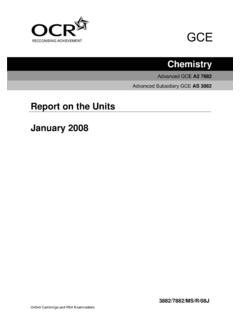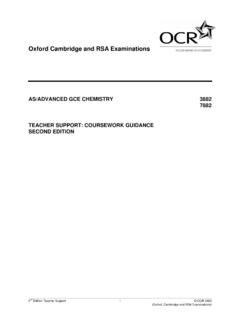Transcription of Advanced GCE A2 7882 - Frankly Chemistry
1 GCE. Chemistry Advanced GCE A2 7882 . Advanced Subsidiary GCE AS 3882. Combined Mark Schemes And Report on the Units June 2005. 3882/ 7882 /MS/R/05. Oxford Cambridge and RSA Examinations OCR (Oxford, Cambridge and RSA Examinations) is a unitary awarding body, established by the University of Cambridge Local Examinations Syndicate and the RSA Examinations Board in January 1998. OCR provides a full range of GCSE, A. level, GNVQ, Key Skills and other qualifications for schools and colleges in the United Kingdom, including those previously provided by MEG and OCEAC. It is also responsible for developing new syllabuses to meet national requirements and the needs of students and teachers. This mark scheme is published as an aid to teachers and students, to indicate the requirements of the examination. It shows the basis on which marks were awarded by Examiners. It does not indicate the details of the discussions which took place at an Examiners' meeting before marking commenced.
2 All Examiners are instructed that alternative correct answers and unexpected approaches in candidates' scripts must be given marks that fairly reflect the relevant knowledge and skills demonstrated. Mark schemes should be read in conjunction with the published question papers and the Report on the Examination. OCR will not enter into any discussion or correspondence in connection with this mark scheme. OCR 2005. Any enquiries about publications should be addressed to: OCR Publications PO Box 5050. Annersley NOTTINGHAM. NG15 0DL. Telephone: 0870 870 6622. Facsimile: 0870 870 6621. E-mail: Oxford Cambridge and RSA Examinations CONTENTS. Advanced GCE Chemistry ( 7882 ). Advanced Subsidiary GCE Chemistry (3882). MARK SCHEME ON THE UNITS. Unit Content Page 2811 Foundation Chemistry 1. 2812 Chains and Rings 7. 2813/1 How Far? How Fast? / Experimental 13. Skills 1 Written Paper 2813/3 How Far? How Fast? / Experimental 19.
3 Skills 1 Practical Examination 2814 Chain, Rings and Spectroscopy 27. 2815/1 Trend and Patterns 37. 2815/2 Biochemistry 45. 2815/3 Environmental Chemistry 51. 2815/4 Methods of Analysis and Detection 57. 2815/5 Gases, Liquids and Solids 63. 2815/6 Transition Elements 69. 2816/1 Unifying Concepts in 75. Chemistry /Experimental Skills 2. Written Paper 2816/3 Unifying Concepts in 81. Chemistry /Experimental Skills 2. Practical Examination REPORT ON THE UNITS. Unit Content Page Chief Examiner's Report 88. 2811 Foundation Chemistry 90. 2812 Chains and Rings 93. 2813/1 How Far? How Fast? / Experimental 95. Skills 1 Written Paper 2813/2 How Far? How Fast? / Experimental 98. Skills 1 Coursework 2813/3 How Far? How Fast? / Experimental 100. Skills 1 Practical Examination 2814 Chain, Rings and Spectroscopy 102. 2815/1 Trend and Patterns 105. 2815/2 Biochemistry 108. 2815/3 Environmental Chemistry 110. 2815/4 Methods of Analysis and Detection 112.
4 2815/5 Gases, Liquids and Solids 114. 2815/6 Transition Elements 116. 2816/1 Unifying Concepts in 118. Chemistry /Experimental Skills 2. Written Paper 2816/2 Unifying Concepts in 121. Chemistry /Experimental Skills 2. Coursework 2816/3 Unifying Concepts in 123. Chemistry /Experimental Skills 2. Practical Examination 2811 Mark Scheme June 2005. Mark Scheme 2811. June 2005. 1. 2811 Mark Scheme June 2005. Abbreviations, / = alternative and acceptable answers for the same marking point annotations and ; = separates marking points conventions NOT = answers which are not worthy of credit () = words which are not essential to gain credit used in the Mark = (underlining) key words which must be used to gain credit Scheme ecf = error carried forward AW = alternative wording ora = or reverse argument Question Expected Answers Marks 1 (a) (i) atoms of same element/same atomic number .. with different numbers of neutrons/different masses [1].
5 (ii). isotope protons neutrons electrons 46. Ti 22 24 22. 47. Ti 22 25 22. [2]. (b). (46 x ) + (47 x ) + (48 x ). Ar = 100 / [2]. = (c) 1s22s22p63s23p63d24s2 [1]. - - - (d) (i) + - + - +. - - - - + - + - + - +. - - - - + - + - +. - - - positive ions electrons (must be labelled) [2]. (ii) electrons move [1]. (e) (i) moles Ti = = mol [1]. (accept use of answer from (b)). (ii) mass of Cl = = g moles Cl = = mol [2]. = mol gets 1 mark Ti:Cl = : = 1:4. (iii). Empirical formula = TiCl4. : mol gives TiCl5 for 1 mark [1]. Ti + 2Cl2 TiCl4 [1]. (iv) (ecf possible from (iii). covalent (v) simple molecular [2]. Total: 16. 2. 2811 Mark Scheme June 2005. Abbreviations, / = alternative and acceptable answers for the same marking point annotations and ; = separates marking points conventions NOT = answers which are not worthy of credit () = words which are not essential to gain credit used in the Mark = (underlining) key words which must be used to gain credit Scheme ecf = error carried forward AW = alternative wording ora = or reverse argument Question Expected Answers Marks 2 (a) RaCl2 [1].)
6 (b) Reduction is gain of electrons/decrease in oxidation number Ra2+ gains 2 electrons Ra/. Oxidation state goes from +2 in RaCl2 0 in Ra [2]. (c) (i) effervescence/bubbles Ra disappears/dissolves [2]. (ii) 8-14 [1]. (d) (i) First ionisation (energy) [2]. Ra(g) Ra+(g) + e . 1 mark for equation 1 mark for state symbols ' not required on e' [2]. atomic radii of Ra > atomic radii of Ca/. (ii). Ra has electrons in shell further from nucleus than Ca/. Ra has more shells Ra has more shielding than Ca : more' is essential Ra electron held less tightly/less attraction on electron [3]. Total: 13. 3. 2811 Mark Scheme June 2005. Abbreviations, / = alternative and acceptable answers for the same marking point annotations and ; = separates marking points conventions NOT = answers which are not worthy of credit () = words which are not essential to gain credit used in the Mark = (underlining) key words which must be used to gain credit Scheme ecf = error carried forward AW = alternative wording ora = or reverse argument Question Expected Answers Marks 3 (a) Mg(OH)2(s) + 2 HCl(aq).
7 MgCl2(aq) + 2 H2O(l). [1]. (b) (i) moles HCl = x 500/1000 = [1]. (ii) moles Mg(OH)2 = x moles HCl = molar mass of Mg(OH)2 = + 17x2 = (do not penalise 24). mass Mg(OH)2 = x = g / g (accept ans from (ii) x = g). [3]. (mass Mg(OH)2 of g would score 2 marks as ecf' as molar ratio has not been identified). Too much if g (dose) > ans to (ii). (iii) (If answer to (ii) > g then correct' response here would [1]. be Not enough'. (c) CaCO3 reacts with (or neutralises) HCl (or CaCO3 + HCl in an equation). CaCO3 + 2 HCl CaCl2 + H2O + CO2 [2]. (correct equation would score both marks). Total: 8. 4. 2811 Mark Scheme June 2005. Abbreviations, / = alternative and acceptable answers for the same marking point annotations and ; = separates marking points conventions NOT = answers which are not worthy of credit () = words which are not essential to gain credit used in the Mark = (underlining) key words which must be used to gain credit Scheme ecf = error carried forward AW = alternative wording ora = or reverse argument Question Expected Answers Marks 4 (a) Cl2(g) NaOCl(aq) : Cl(0) Cl(+1).)
8 Cl2(g) NaCl(aq) : Cl(0) Cl( 1). Cl is both oxidised (in forming NaOCl) and reduced (in forming NaCl)/disproportionation Cl reduces Cl to form NaCl AND Cl oxidises Cl in forming NaOCl [3]. (b) (i) Cl2 + 2I I2 + 2Cl [2]. 1 mark for species. 1 mark for balancing (ii) Cl atom is smaller/has less shells electron to be captured will be attracted more [2]. Total: 7. 5. 2811 Mark Scheme June 2005. Abbreviations, / = alternative and acceptable answers for the same marking point annotations and ; = separates marking points conventions NOT = answers which are not worthy of credit () = words which are not essential to gain credit used in the Mark = (underlining) key words which must be used to gain credit Scheme ecf = error carried forward AW = alternative wording ora = or reverse argument Question Expected Answers Marks 5 (a) (i) H bonding from O of 1 H2O molecule to H of another dipoles shown with lone pair involved in bond [3].
9 (ii) Two properties from: Ice is lighter than water/ max density at 4 C. explanation: H bonds hold H2O molecules apart / open lattice in ice / H-bonds are longer Higher melting/boiling point than expected explanation: strength of H bonds that need to be broken must imply that intermolecular bonds are broken High surface tension/viscosity explanation strength of H bonds across surface [4]. (b) NH3: 107 (range 106 108 ). electron pairs repel other electron pairs lone pair has more repulsion electron pairs get as far apart as possible [4]. (c) N has less protons than O (ora). electrons are in same shell /have same or similar shielding weaker nuclear attraction in N (ora). shell drawn in less by nuclear charge in N (ora) [4]. watch for distinction between nuclear attraction and nuclear charge in candidates' scripts. QoWC: links together two statements in at least two of the sections (a)(ii), (b) and (c). [1]. Total: 16.
10 6. 2812 Mark Scheme June 2005. Mark Scheme 2812. June 2005. 7. 2812 Mark Scheme June 2005. 1. (a) C6H14. (b) (i) boiling point increases with increase in MR/molecular formula/No of carbon atoms/chain length (ii) more intermolecular forces/electrons/surface area/. surface interactions/van der Waal forces (iii) 120 130 oC. (c)(i) C9H20 C7H16 + C2H4. (ii) C2H4 + H2O C2H5OH. temperature > 100 oC/ steam phosphoric acid (catalyst). (d) (i). or or or (ii) 85 98 oC. (e). C7H16 C6H11CH3 / + H2. H2 as a product C7H14 + H2. C7H16 either of these scores 1 mark (f) more efficient fuel/better fuel/ higher octane number/reduces knocking/more volatile/lower boiling points/burn better/burn more easily/quicker [Total: 13]. 8. 2812 Mark Scheme June 2005. 2. (a) (i) reaction 1. (ii) reaction 4. (iii) reaction 3. (b) (i) lone pair/electron pair donor + - H3C CH2 CH2 Cl H3C CH2 CH2 OH + - Cl .. - OH. Correct dipole Curly arrow from the O in the OH- to C in the CH2.
